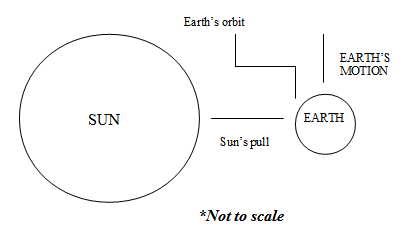Activity 1: Online Orbital Simulation
Give students copies of the Online Orbital Simulation worksheet (S-5-4-3_Online Orbital Simulation and KEY.docx). Circulate around the classroom while students complete the activity and troubleshoot any challenges they may have.
Activity 2: Planetary Orbits
Go outside and have students spin a tether ball around in a circle. If your school does not have tetherball equipment, connect a ball to a pole with a rope.
When doing this, emphasize that:
-
The ball represents Earth.
-
The pole represents the Sun.
-
The rope that holds the two together represents the force of gravity.
Explain that “letting go of the rope” is equivalent to “turning off gravity.”
“If you hit the tether ball and then cut the rope, what path would the ball take?” Continue to hit the ball around the pole as you field answers. (The ball would fly away from the pole.)
“Now imagine Earth revolving or orbiting around the sun. What would happen if you turned off gravity? What path would Earth take?” (Earth would fly away from the sun.)
“The tether ball is hit, which gives it motion, and we know that Earth has motion as it orbits around the sun. What word can we use to explain that both the tetherball and Earth tend to stay in motion?” (inertia)
“The sun has the most mass in the solar system at 99.8%. That means that if you took all the mass in the entire solar system, including Earth, all the planets, meteors, and moons, and divided it into 100 equal parts, the sun would have more than 99 of those parts. That’s really big!”
“If the sun is so massive that it has the most gravity by far in the solar system, why doesn’t the sun pull tiny Earth into it?”
“The Earth has been in motion for billions of years. We don’t know exactly why or how Earth started moving, but it does move. Earth’s inertia is keeping it in motion. The sun is always trying to pull Earth in at all times, so what happens is that the Earth’s orbit is a compromise between the two motions.”
Take students back to the classroom. Draw the diagram below on the board and explain the motion of the Earth. Have students explain how this diagram relates to the motion of the tetherball.

Activity 3: Comparing Models Worksheet
Have students complete the Planetary Orbits Worksheet (S-5-4-3_Planetary Orbits Worksheet and KEY.doc). When they are finished, draw the table on the board and have students share their ideas. Record valid answers on the board, and have students add to their tables as ideas are shared. Students should demonstrate an understanding that different models can be used to represent the solar system with each model having its own strengths and weaknesses.
Extension:
-
For students requiring additional practice, create mixed-ability pairs for the online simulation activity. Also, go over the answers to the worksheets with students and have them add to and revise their answers when needed.
-
Students ready to go above and beyond the standards can do the Your Weight on Other Worlds activity online (see Related Resources) if they finish the online simulation activity early. Have them summarize the results of the activity in a paragraph.
